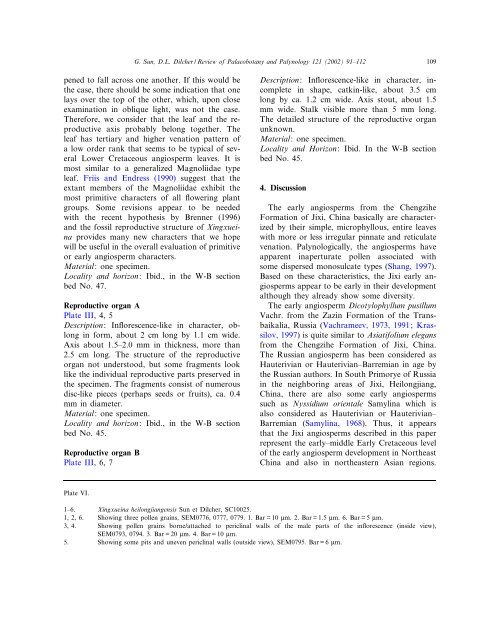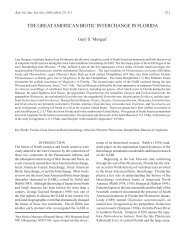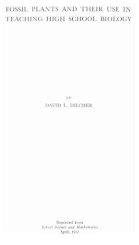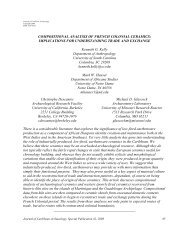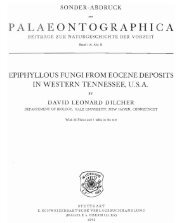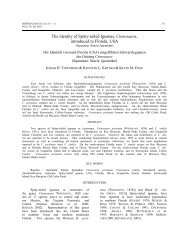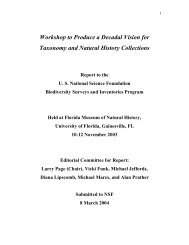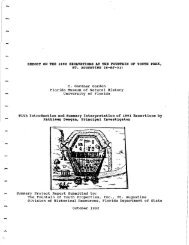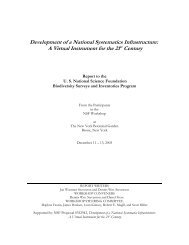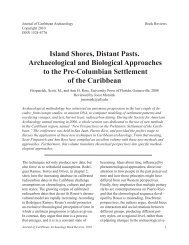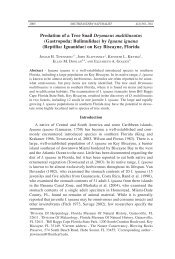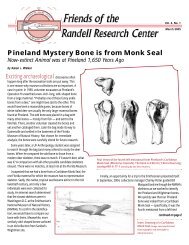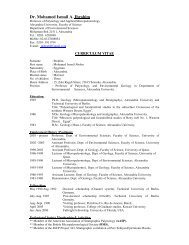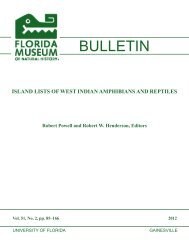Early angiosperms from the Lower Cretaceous of Jixi, eastern ...
Early angiosperms from the Lower Cretaceous of Jixi, eastern ...
Early angiosperms from the Lower Cretaceous of Jixi, eastern ...
You also want an ePaper? Increase the reach of your titles
YUMPU automatically turns print PDFs into web optimized ePapers that Google loves.
pened to fall across one ano<strong>the</strong>r.If this would be<br />
<strong>the</strong> case, <strong>the</strong>re should be some indication that one<br />
lays over <strong>the</strong> top <strong>of</strong> <strong>the</strong> o<strong>the</strong>r, which, upon close<br />
examination in oblique light, was not <strong>the</strong> case.<br />
Therefore, we consider that <strong>the</strong> leaf and <strong>the</strong> reproductive<br />
axis probably belong toge<strong>the</strong>r.The<br />
leaf has tertiary and higher venation pattern <strong>of</strong><br />
a low order rank that seems to be typical <strong>of</strong> several<br />
<strong>Lower</strong> <strong>Cretaceous</strong> angiosperm leaves.It is<br />
most similar to a generalized Magnoliidae type<br />
leaf. Friis and Endress (1990) suggest that <strong>the</strong><br />
extant members <strong>of</strong> <strong>the</strong> Magnoliidae exhibit <strong>the</strong><br />
most primitive characters <strong>of</strong> all £owering plant<br />
groups.Some revisions appear to be needed<br />
with <strong>the</strong> recent hypo<strong>the</strong>sis by Brenner (1996)<br />
and <strong>the</strong> fossil reproductive structure <strong>of</strong> Xingxueina<br />
provides many new characters that we hope<br />
will be useful in <strong>the</strong> overall evaluation <strong>of</strong> primitive<br />
or early angiosperm characters.<br />
Material: one specimen.<br />
Locality and horizon: Ibid., in <strong>the</strong> W-B section<br />
bed No.47.<br />
Reproductive organ A<br />
Plate III, 4,5<br />
Description: In£orescence-like in character, oblong<br />
in form, about 2 cm long by 1.1 cm wide.<br />
Axis about 1.5^2.0 mm in thickness, more than<br />
2.5 cm long. The structure <strong>of</strong> <strong>the</strong> reproductive<br />
organ not understood, but some fragments look<br />
like <strong>the</strong> individual reproductive parts preserved in<br />
<strong>the</strong> specimen.The fragments consist <strong>of</strong> numerous<br />
disc-like pieces (perhaps seeds or fruits), ca.0.4<br />
mm in diameter.<br />
Material: one specimen.<br />
Locality and horizon: Ibid., in <strong>the</strong> W-B section<br />
bed No.45.<br />
Reproductive organ B<br />
Plate III, 6,7<br />
Plate VI.<br />
G. Sun, D.L. Dilcher / Review <strong>of</strong> Palaeobotany and Palynology 121 (2002) 91^112 109<br />
Description: In£orescence-like in character, incomplete<br />
in shape, catkin-like, about 3.5 cm<br />
long by ca. 1.2 cm wide. Axis stout, about 1.5<br />
mm wide.Stalk visible more than 5 mm long.<br />
The detailed structure <strong>of</strong> <strong>the</strong> reproductive organ<br />
unknown.<br />
Material: one specimen.<br />
Locality and Horizon: Ibid.In <strong>the</strong> W-B section<br />
bed No.45.<br />
4. Discussion<br />
The early <strong>angiosperms</strong> <strong>from</strong> <strong>the</strong> Chengzihe<br />
Formation <strong>of</strong> <strong>Jixi</strong>, China basically are characterized<br />
by <strong>the</strong>ir simple, microphyllous, entire leaves<br />
with more or less irregular pinnate and reticulate<br />
venation.Palynologically, <strong>the</strong> <strong>angiosperms</strong> have<br />
apparent inaperturate pollen associated with<br />
some dispersed monosulcate types (Shang, 1997).<br />
Based on <strong>the</strong>se characteristics, <strong>the</strong> <strong>Jixi</strong> early <strong>angiosperms</strong><br />
appear to be early in <strong>the</strong>ir development<br />
although <strong>the</strong>y already show some diversity.<br />
The early angiosperm Dicotylophyllum pusillum<br />
Vachr.<strong>from</strong> <strong>the</strong> Zazin Formation <strong>of</strong> <strong>the</strong> Transbaikalia,<br />
Russia (Vachrameev, 1973, 1991; Krassilov,<br />
1997) is quite similar to Asiatifolium elegans<br />
<strong>from</strong> <strong>the</strong> Chengzihe Formation <strong>of</strong> <strong>Jixi</strong>, China.<br />
The Russian angiosperm has been considered as<br />
Hauterivian or Hauterivian^Barremian in age by<br />
<strong>the</strong> Russian authors.In South Primorye <strong>of</strong> Russia<br />
in <strong>the</strong> neighboring areas <strong>of</strong> <strong>Jixi</strong>, Heilongjiang,<br />
China, <strong>the</strong>re are also some early <strong>angiosperms</strong><br />
such as Nyssidium orientale Samylina which is<br />
also considered as Hauterivian or Hauterivian^<br />
Barremian (Samylina, 1968).Thus, it appears<br />
that <strong>the</strong> <strong>Jixi</strong> <strong>angiosperms</strong> described in this paper<br />
represent <strong>the</strong> early^middle <strong>Early</strong> <strong>Cretaceous</strong> level<br />
<strong>of</strong> <strong>the</strong> early angiosperm development in Nor<strong>the</strong>ast<br />
China and also in nor<strong>the</strong>astern Asian regions.<br />
1^6. Xingxueina heilongjiangensis Sun et Dilcher, SC10025.<br />
1, 2, 6.Showing three pollen grains, SEM0776, 0777, 0779.1.Bar = 10 Wm.2.Bar = 1.5 Wm.6.Bar = 5 Wm.<br />
3, 4.Showing pollen grains borne/attached to periclinal walls <strong>of</strong> <strong>the</strong> male parts <strong>of</strong> <strong>the</strong> in£orescence (inside view),<br />
SEM0793, 0794.3.Bar = 20 Wm.4.Bar = 10 Wm.<br />
5.Showing some pits and uneven periclinal walls (outside view), SEM0795.Bar = 6 Wm.


